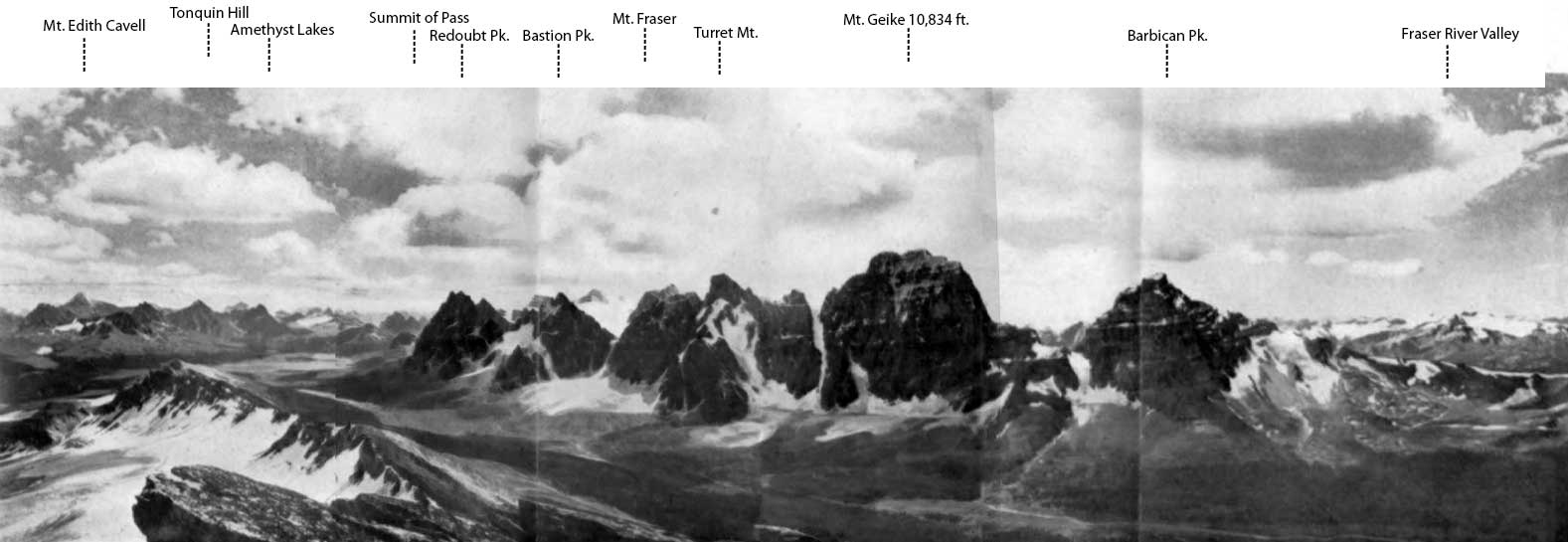E of Raush Glacier in Premier Range
52.705 N 119.6736 W — Map 083D12 — Google — GeoHack
Name officially adopted in 1962
Official in BC – Canada
Descriptive. A trigon is a triangle or triangular shaped body.
Descriptive. A trigon is a triangle or triangular shaped body.
A treadmill is a horizontal cylinder made to revolve by persons walking on its periphery. Though doing work, they do not gain any distance.
The feature was named by the Alberta-British Columbia Boundary Commission in 1922.
After Thomas Torpy, a tunnel construction foreman during the building of the Grand Trunk Pacific Railway.
In the report of his survey of the upper Fraser River in 1910, John A. Coryell mentioned the Torpy Range, “where grizzly bear are plentiful and black bear through the bench lands, where they can feast on the raspberries, huckleberries, blueberries, low-bush and high-bush cranberries found throughout this valley. Beaver are too plentiful for the comfort of the actual settler when he invades this district, and marten have been trapped for years. Three trappers and several Indians were in the district when the survey was completed.”
Formerly called the Clearwater River.
Named in association with Tonquin Pass.

Tonquin Pass is mentioned by surveyor Richard William Cautley [1873–1953] of the Alberta-British Columbia Boundary Commission in 1922.
“Tonquin Pass has no history, as far as your Commissioners are aware,” wrote Cautley’s associate, boundary commissioner Arthur Oliver Wheeler [1860–1945] in 1924. “The name, Tonquin, as applied to the valley and the part of it that constitutes the pass over the continental watershed, was given by the Geographic Board of Canada. It was conferred in commemoration of John Jacob Astor’s ship, the Tonquin, which in 1810 sailed from New York and founded Fort Astoria, a trading post at the mouth of the Columbia River.”
Leaving Astoria, the Tonquin sailed to Clayoquot to trade for furs, where the insolence of Captain Thorn so outraged the native Americans that they seized the ship and massacred all but three or four of the crew. These survivors, before escaping in the ship’s boat, lit a fuse leading to the Tonquin’s powder magazine. Some 200 local inhabitants were killed when the ship blew up.
Named in association with Tonquin Pass.
Named in association with Tonquin Pass.
Origin of the name unknown. Location approximate.
Peter (1886-1965) and Olympia (1892-1962) Tityrn and six children moved to McBride in 1925. Another two children were born in the valley. Peter came to Canada as a boy from the Ukraine. He started a long career on the railroad in 1902 as a track laborer in Manitoba. At Portage la Prairie in 1906, he joined the Grand Trunk Pacific, and moved west with the construction gangs. In 1914, at Fort Fraser, British Columbia, in charge of a gang of 400 men, he drove the last spike linking east with west on the north line.
The Canadian National Railroad inherited the bankrupt Grand Trunk Pacific in 1921. Tityrn served on various sections of the CNR’s Smithers division before moving to McBride, where he bought a quarter-section east of town. He continued to work for the railroad while clearing the land, with the help of sons Walter and William. He retired in 1950 and moved into McBride. Peter was a charter member of the McBride Elks and a member of the Farmers’ Institute.
Before Tityrn Road was high graded and widened, it would drift in with snow in the fall and remain that way until spring. The only way out was with horse and sleigh, or on foot. “Though we had to walk that long road to school and town, there are still many fond memories of a happy, ambitious, hard-working family who once lived at the end of this road,” recalls Rose Callaghan (nee Tityrn).